Iconic Trees of Natural Lands
Over time, trees can become landmarks, as iconic as a skyline or a mountain range. Trees can be celebrities, growing and changing with the seasons, as familiar as family.
Old trees are precious since they sequester more carbon, and make more oxygen, than a young tree. Yet, even if we didn’t know the science, we understand that the loss of an old tree is significant. So, let’s celebrate some of Natural Lands living iconic trees; those who are giants, those who are old, and the familiar friends on the hill.
Bryn Coed Preserve
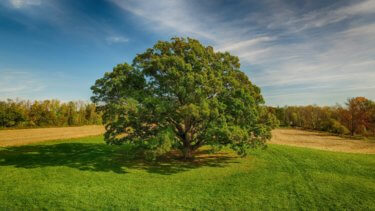
Mark Williams
The white oak at Bryn Coed Preserve has been known to stop travelers in their tracks. This tree was the image that a community rallied around to protect Bryn Coed Preserve in Chester County. The magnificent size and shape of this tree has made it a local celebrity.
Natural Lands planted over 12,000 trees since taking ownership of Bryn Coed Preserve, so one day this oak will be an ancient grandfather looking over a young forest.
Glades Wildlife Refuge
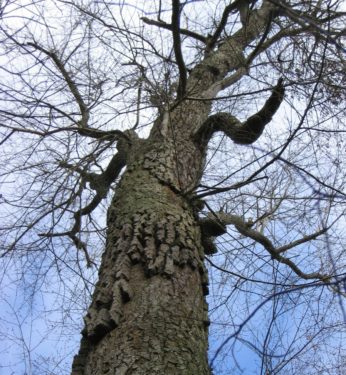
Photo: Abigail Harris-Culver
The famous black gum trees at Glades Wildlife Refuge are an hour hike from the nearest road. Yet, even though they are remote, these trees have been the subjects of journalism by the New York Times and The Philadelphia Inquirer. Located deep in the Bear Swamp section of the preserve it takes a guide and some grit to see these celebrities.
If you are able to make the hike you may find yourself at the foot of a tree that is estimated to be around 600 years old. There are those that say these trees may be older, but since they are hollow, it’s impossible to be sure. In other trees, a hollow core might be a cause for concern, but in these trees it’s all part of the natural aging process. Those their structure makes them difficult to date, it is also the factor that may have spared them from being cut down when the area was logged.
Yet we may be the last generation to lay a hand on their living bark, as sea levels rise, and salt water encroaches into the swamp.
Stoneleigh: a natural garden
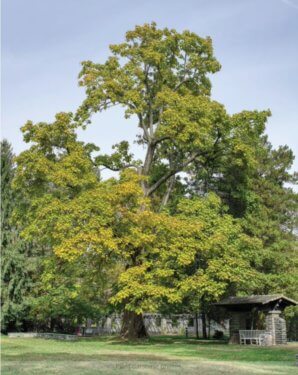
Photo: David Korbonits
Once a family home, now a public garden, Stoneleigh celebrates the beauty of native plants and the importance of biodiversity. Many of Stoneleigh’s largest trees were planted more than a century ago by some of the most influential landscape architects of their day, including the Olmsted Brothers firm. Several native specimens at Stoneleigh are among the largest of their kind in the state.
One of the many big trees at Stoneligh is the southern catalpa, which inspired the name of the new water garden: Catalpa Court. The Stoneleigh catalpa is the third largest of its kind in Pennsylvania, with a massive trunk measuring 204 inches around and a spread of 63 feet. The tree measures 82 feet tall, a remarkable height for a species that usually caps out at half that. Its height is even more remarkable, considering the Stoneleigh tree lost a huge section of its main trunk in a storm decades ago.
The southern catalpa is one of many incredible trees at Stoneleigh. Click here to learn more about the magnificent cucumber magnolia, eastern arborvitae, eastern hemlock, European turkey oak, and the Franklin tree that live in the garden.
Crow’s Nest Preserve
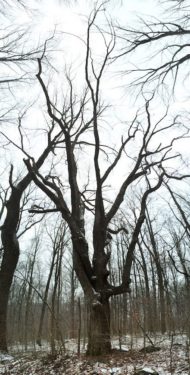
Photo: Daniel Barringer
There is a tree in Elverson Pennsylvania that holds stories of love in its branches. The black gum with the right angled branch at Crow’s Nest Preserve is believed to be 150 years old. Local lore says that this tree was the site of romance in the 19th century, when couples would court at the swing hanging from its lowest branch. Now the “courting tree” grows in the protected landscape of Crow’s Nest Preserve, turning brilliant crimson in the fall, with a crown of snow in wintertime.
Today, Crow’s Nest is part of one of the largest areas of protected land in the region, insuring that trees like this can continue to grow in the safety of a conserved landscape. While Crow’s Nest Preserve may still be a great place for a date, these days it’s better known for hosting both after-school programs, and a summer day camp. The preserve includes a NaturePlayGround to encourage creative, unstructured play, and hosts a variety of outdoor education programs for all ages.
Want to learn more about the giant trees at Crow’s Nest Preserve? Check out this post by preserve manager Daniel Barringer to learn more about the special trees at Crow’s Nest.
Stroud Preserve
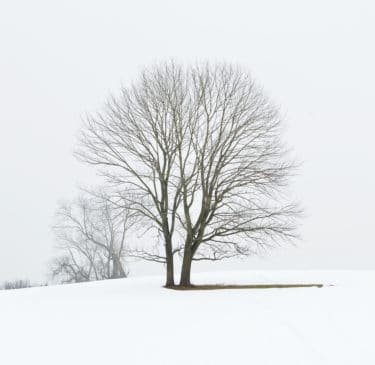
Photo: Mae Axelrod
These two trees at Stroud Preserve prove that you don’t have to be the oldest or the largest to be an icon. While they aren’t setting any records for size, they are well known because of their location and position. Seen at the top of the hill near the main entrance they have become as recognizable as old friends to frequent visitors. Growing so close, and in such symmetry, they are like mirrors of one another, perfect partners reaching for the sky.
Stroud Preserve is a mosaic of once-pastured grasslands, working farmlands, and woodlands that serves as a unique site for recreation, education, and scientific research. Here, you can see the needs of people and nature in balance as careful stewardship of both cultivated and “wild” areas restores vital wildlife habitat while also protecting watersheds that provide drinking water for tens-of-thousands of people.
400- year old Penn Oak
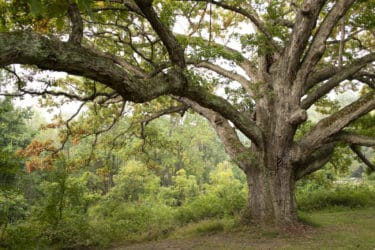
This centuries-old white oak is one of “Penn’s Trees,” thought to pre-date European colonization.
Photo: Mae Axelrod
This magnificent white oak tree is growing on private property held under easement by Natural Lands. At about 400 years old, this tree has seen history happen, and to stand at it’s base is to know that you are in the presence of greatness. The large limbs stretch outward impossibly far, as if they were laughing at gravity.
In 1932, during the 250th anniversary of Pennsylvania’s founding, a Philadelphia science teacher set out to identify and document surviving “Penn’s trees,” specimens that were alive when the colony was occupied by European settlers. In 1977, the Penn Tree Committee updated the list, identifying 130 trees they believed were at least 300 years old. This white oak tree is one such survivor, now among only 100 believed to remain.
Trees are living history. Our familiar trees become dear to us as we pass by them on our lives. While both of us may change we take comfort in knowing that they may outlive us, their canopies a constant we can rely on. Yet trees have lifespans just as we do. While some trees may live hundreds of years, their lives, like ours, will someday end.
While we may be sad to see a familiar tree go, we must understand that it is in our power to grow the next generation of giants. If we can step in the shade of a tree planted before our birth, it is ours to plant the sapling to become the ancient trees of tomorrow.
